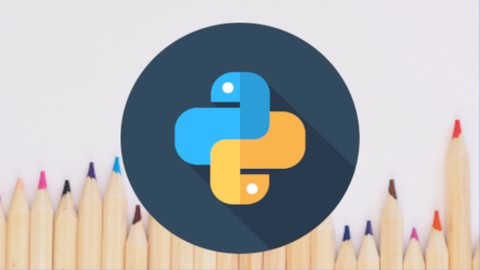
Python Quick Start Tutorial for Beginners
Python Quick Start Tutorial for Beginners, available at Free, has an average rating of 4.4, with 32 lectures, based on 126 reviews, and has 5282 subscribers.
You will learn about Python syntax and basics, builtin functions list, tuple, set, dictionary classes and object oriented, working with files, error handling, data visualization and basics of web application. This course is ideal for individuals who are Students, early learners of Python in fast pace It is particularly useful for Students, early learners of Python in fast pace.
Enroll now: Python Quick Start Tutorial for Beginners
Summary
Title: Python Quick Start Tutorial for Beginners
Price: Free
Average Rating: 4.4
Number of Lectures: 32
Number of Published Lectures: 32
Number of Curriculum Items: 32
Number of Published Curriculum Objects: 32
Original Price: Free
Quality Status: approved
Status: Live
What You Will Learn
- Python syntax and basics, builtin functions
- list, tuple, set, dictionary
- classes and object oriented, working with files, error handling,
- data visualization and basics of web application.
Who Should Attend
- Students, early learners of Python in fast pace
Target Audiences
- Students, early learners of Python in fast pace
Welcome to Python Quick start tutorial course. What you will learn in this course: Fundamentals of python, functions, list, tuple, set, dictionary, classes and object oriented, working with files, error handling, data visualization and basics of web application with python.
Syntax in python is simple and easy to read and understand. And by syntax we mean a set of rules that define how to write a correct Python program. It includes rules for naming variables, using punctuation, formatting code, defining methods, etc. We will cover the fundamental ones in section 1.
Python supports several data types including integers, floats, strings, booleans, lists and so on. The primitive data types are covered in section 2. Python also has many built-in functions that can be used without the need to import any additional modules.
In section 3, I explain python decision flow with if, else if and else statements. I also teach you how to write for loop and while loop in python. At the end of this section, you are challenged to write your own code to program a traffic speed camera. You will find it easy and fun after watching this video.
In section 4, you will understand how to use functions and modules in Python.
The remaining of the sections is as follows:
5. List, Tuple
6. Sets, Dictionaries
7. Classes and Object Oriented
8. Files
9-11. (will be added)
Course Curriculum
Chapter 1: The Basics of Python Part 1
Lecture 1: Syntax, comments, and variables
Lecture 2: Operators and expressions
Chapter 2: The basics of Python Part 2
Lecture 1: Data types and built-in functions
Lecture 2: Run Python Code
Chapter 3: Conditions and Loops
Lecture 1: if, elif, else
Lecture 2: for and while loops
Lecture 3: Coding challenge 1
Chapter 4: Functions and Modules
Lecture 1: Functions and Function Scope
Lecture 2: Modules: Builtin and User Defined
Lecture 3: Coding challenge 2
Chapter 5: List and Tuple
Lecture 1: Data Structure and Lists
Lecture 2: Tuples
Chapter 6: Sets and Dictionaries
Lecture 1: Sets
Lecture 2: Dictionaries
Lecture 3: Coding challenge 3
Chapter 7: Classes and Object Oriented
Lecture 1: Class and Object
Lecture 2: Inheritance and Polymorphism
Lecture 3: Coding challenge 4
Chapter 8: Files
Lecture 1: Open and Read a File
Lecture 2: Writing to a File
Lecture 3: CSV Files
Lecture 4: Coding challenge 5
Chapter 9: Error Handling
Lecture 1: Errors and Exceptions
Lecture 2: try-except block
Lecture 3: Custom Exception and Assertion
Lecture 4: Coding Challenge
Chapter 10: Data Visualization
Lecture 1: Creating Charts
Lecture 2: Coding Challenge
Chapter 11: Web Applications
Lecture 1: Create Your First Web App
Lecture 2: Web App with Templates
Lecture 3: Pass Data using GET Method
Lecture 4: Coding Challenge
Instructors
-
Mehdi Mohammadi
Machine Learning Engineer
Rating Distribution
- 1 stars: 4 votes
- 2 stars: 2 votes
- 3 stars: 21 votes
- 4 stars: 39 votes
- 5 stars: 60 votes
Frequently Asked Questions
How long do I have access to the course materials?
You can view and review the lecture materials indefinitely, like an on-demand channel.
Can I take my courses with me wherever I go?
Definitely! If you have an internet connection, courses on Udemy are available on any device at any time. If you don’t have an internet connection, some instructors also let their students download course lectures. That’s up to the instructor though, so make sure you get on their good side!
You may also like
- Top 10 Content Creation Courses to Learn in December 2024
- Top 10 Game Development Courses to Learn in December 2024
- Top 10 Software Testing Courses to Learn in December 2024
- Top 10 Big Data Courses to Learn in December 2024
- Top 10 Internet Of Things Courses to Learn in December 2024
- Top 10 Quantum Computing Courses to Learn in December 2024
- Top 10 Cloud Computing Courses to Learn in December 2024
- Top 10 3d Modeling Courses to Learn in December 2024
- Top 10 Mobile App Development Courses to Learn in December 2024
- Top 10 Graphic Design Courses to Learn in December 2024
- Top 10 Videography Courses to Learn in December 2024
- Top 10 Photography Courses to Learn in December 2024
- Top 10 Language Learning Courses to Learn in December 2024
- Top 10 Product Management Courses to Learn in December 2024
- Top 10 Investing Courses to Learn in December 2024
- Top 10 Personal Finance Courses to Learn in December 2024
- Top 10 Health And Wellness Courses to Learn in December 2024
- Top 10 Chatgpt And Ai Tools Courses to Learn in December 2024
- Top 10 Virtual Reality Courses to Learn in December 2024
- Top 10 Augmented Reality Courses to Learn in December 2024






















